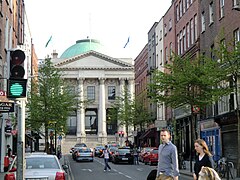City Hall, Dublin
| City Hall, Dublin | |
|---|---|
| Halla na Cathrach, Baile Átha Cliath | |

Dublin City Hall, as viewed from Parliament Street
|
|
| Former names | The Royal Exchange |
| General information | |
| Address | Dame St, Dublin 2 |
| Town or city | Dublin |
| Country | Ireland |
| Coordinates | 53°20′38″N 6°16′02″W / 53.343854°N 6.267154°W |
| Elevation | 8 metres (26 ft) |
| Construction started | 1769 |
| Completed | 1779 |
| Design and construction | |
| Architect | Thomas Cooley |
The City Hall, Dublin (Irish: Halla na Cathrach, Baile Átha Cliath), originally the Royal Exchange, is a civic building in Dublin, Ireland. It was built between 1769 and 1779 to the designs of architect Thomas Cooley and is a notable example of 18th-century architecture in the city.
Located at the top of Parliament Street on the city's southern side, it stands next to Dublin Castle, the centre of the British government in Ireland until 1922. The street had been built in 1753, providing a continuation of Capel Street on the north bank of the Liffey, across the newly widened Essex Bridge, and so the exchange ended (and still ends) a long streetscape.
The external structure is primarily made out of white Portland stone from a quarry in Dorset. The large size and fine fittings of the Royal exchange, with carved capitals by Simon Vierpyl, and plasterwork by the leading stuccodore Charles Thorpe, reflect the standing and prestige of Dublin in the 18th Century. The neo-classical building contains a central entrance hall or Rotunda, with a large dome supported by twelve columns which are surrounded by an ambulatory where the merchants strolled and discussed business meetings.
The function of the building was to provide a meeting place for Dublin's businessmen, where they could buy and sell goods and trade bills of exchange. It was also close to the then Customs House that stood on the site of today's Clarence Hotel, making it convenient for overseas merchants. The cost of building the exchange was met by the Parliament of Ireland, and this is reflected by the initials "SPQH", standing for "Senatus PopulusQue Hibernicus", meaning "The senate and people of Ireland" (an Irish version of SPQR).
The city government had originally been located in the mediæval Tholsel at the corner of Nicholas Street and Christchurch Place, some 300 metres to the west (where the 'Peace Park' is today), and before that on the Thingmount, where Suffolk Street now runs. In the 18th century, meetings were held in South William Street (formerly the Civic Museum).
...
Wikipedia
